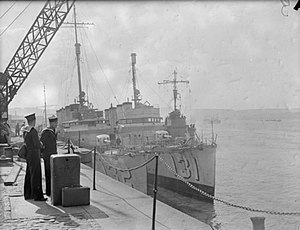 The newly transferred HMS Campbeltown (right) alongside her sister HMS Castleton
| |
| History | |
|---|---|
| Name | Buchanan |
| Namesake | Franklin Buchanan |
| Builder | Bath Iron Works, Bath, Maine, US |
| Laid down | 29 June 1918 |
| Launched | 2 January 1919 |
| Commissioned | 20 January 1919 |
| Decommissioned | In reserve from 1939 |
| Fate | Transferred to the Royal Navy on 3 September 1940 |
| Name | Campbeltown |
| Namesake | |
| Commissioned | 9 September 1940 |
| Honours and awards |
|
| Fate | Expended on 28 March 1942 in a special operation against the docks at Saint-Nazaire |
| Badge | On a Field White, within an annulet Blue charged in base with a mullet White a sprig of myrtle proper. |
| General characteristics | |
| Class and type | |
| Displacement | 1,260 long tons (1,280 t) |
| Length | 314 ft 4 in (95.81 m) |
| Beam | 30 ft 6 in (9.30 m) |
| Draught |
|
| Installed power | 30,000 shp (22,000 kW) |
| Propulsion |
|
| Speed |
|
| Complement | 158 |
| Armament |
|
HMS Campbeltown was a Town-class destroyer of the Royal Navy during the Second World War. She was originally US destroyer USS Buchanan,[1] and was one of 50 obsolescent U.S. Navy destroyers transferred to the Royal Navy in 1940 as part of the Destroyers for Bases Agreement.[2] Campbeltown became one of the most famous of these ships when she was used in the St Nazaire Raid in 1942.
- ^ "HMS Campbeltown, destroyer". www.naval-history.net. Retrieved 2 October 2024.
- ^ "Destroyers for Bases Agreement, 1941". public1.nhhcaws.local. Retrieved 2 October 2024.